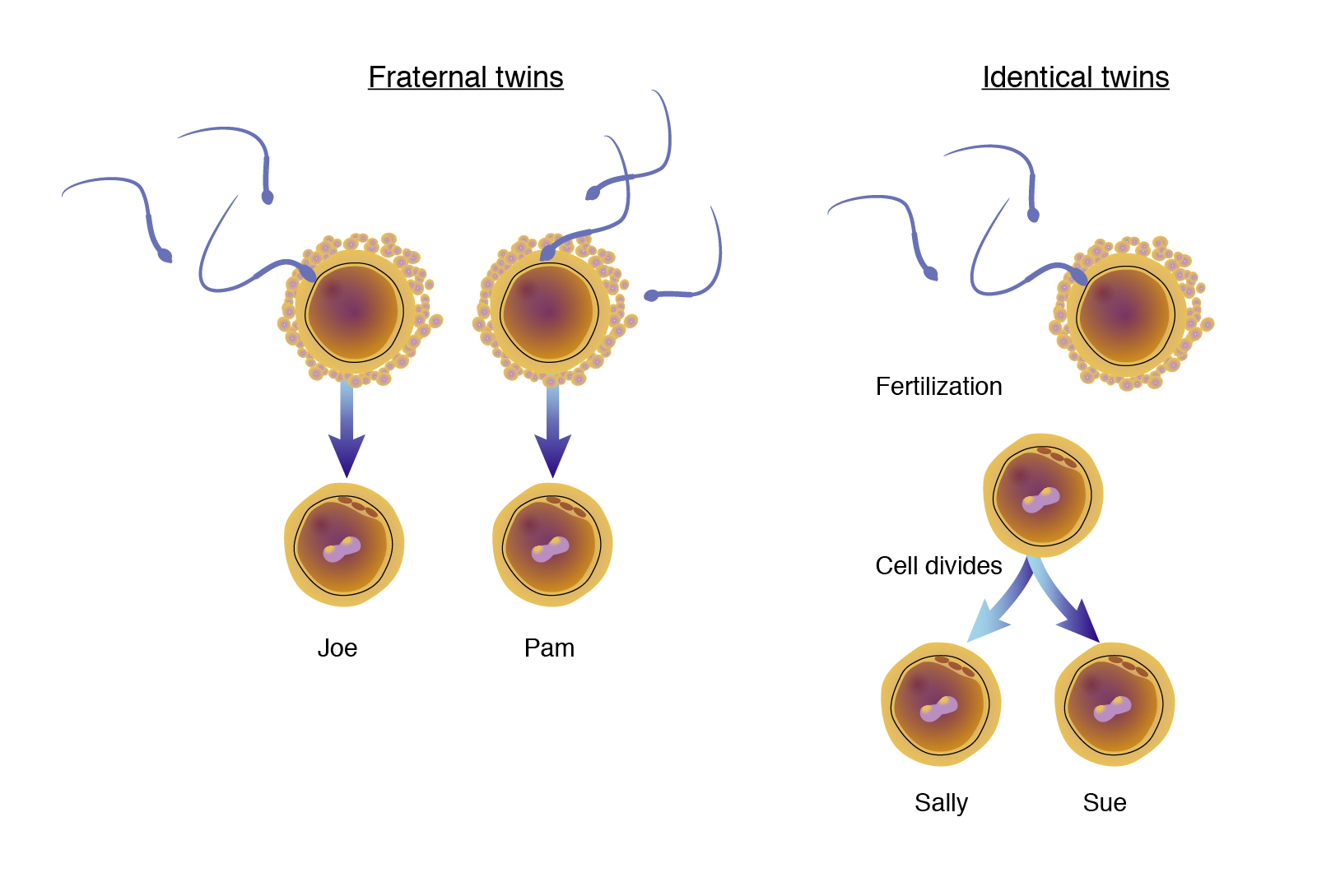People are intrigued by Fraternal Twins or Identical Twins, and there are more twins today than at any other point in history due largely to advancements in infertility research. According to the Centers for Disease Control and Prevention (CDC), 33 out of every 1,000 births in the US were twins in 2017.
Fraternal Twins, or dizygotic, twin have two distinct amniotic sacs, placentas, and supporting components since they are two separate fertilized embryos. Depending on how quick the single fertilized egg splits into two identical twins or monozygotic, Fraternal Twins may or may not share the identical amniotic sac.
If the twins are a boy and a girl, they are obviously fraternal twins because they do not share DNA. A boy’s chromosomes are XY, and girls are XX. When one X egg is generated with an X sperm and the other X egg is fertilized with a Y sperm, girl-boy Fraternal Twins are born.
Based on ultrasound results or analysis of the membranes at the time of birth, health care workers may decide whether same-sex twins are Fraternal Twins or identical. Examining each child’s DNA is the most reliable way to decide whether twins are identical twins or Fraternal. Based on placenta results, a family is often advised that their twins are Fraternal Twins while they are clearly identified.
A family can note slight physical variations between identical twins and consider the Fraternal Twins based on these differences. A few commercial labs can send DNA selection kits to families for a fee to decide if the twins are identical twins or Fraternal Twins. The parents swab the insides of their children’s cheeks for a DNA check and return the package to the clinic, where the findings are awaited.
Fraternal Twins: What Are They?
When two separate eggs are fertilized by two sperm, fraternal twins, also known as dizygotic twins, occur. The word “dizygotic” refers to the zygote, the fertilized egg that will develop into an embryo and mature into an infant. Fraternal twins make up the bulk of twins (twins that are more like siblings born simultaneously). 1 Monozygotic twins, also recognized as identical twins, are formed when a single egg and sperm break in half after pregnancy.

Learn more about fraternal twinning, including how it happens, how it grows, and how it varies from identical twins.
Types of Fraternal Twins
Since fraternal twins are made from separate eggs and semen, it’s likely that the twins may have different gestational ages or even different dads.
Superfetation
Hyperovulation will occur multiple days apart. When one egg has been fertilized and is making the way to the uterus for implantation, semen from a subsequent sexual experience fertilizes another egg. Fraternal, born a few days apart, are the result.
This is referred to as superfecundation.
Superfecundation
Fraternal twins with separate fathers have been identified. When a woman releases multiple eggs and has intimate encounters with multiple partners, this happens. Fraternal twins from separate fathers are produced when an egg is fertilized by sperm from one man and then another egg is fertilized by sperm from another man. Superfecundation is the name for this phenomenon.
Placenta Fusion
The placenta is the organ that feeds the baby during birth. A placenta forms for each baby in a multiple pregnancy of fraternal twins. However, the two placentas will often merge together and appear as a single placenta. Fraternal twins are not at risk for any of the diseases that affect monozygotic twins, such as twin-to-twin transfusion syndrome (TTTS) or monoamniotic twins, and they have their own placentas.
How Are Fraternal Twins Created?

Fraternal twins are formed by the marriage of sperm and egg in the same manner as all humans are created. When more than one egg is released during ovulation, dizygotic twinning occurs. Hyperovulation is the diagnostic name for this.
Hyperovulation can occur for a number of reasons, including:
- Height: Twin births are more common in taller women than in shorter women.
- High body mass index (BMI > 30): Extra fat stores contain higher estrogen levels.
- Maternal age: You’re more likely to hyperovulate as you get older.
- Multiple births: Mothers who have had multiple children in the past could be more likely to have twins.
- Race: The highest rates of twinning are seen in Central African cultures, while the lowest rates are seen in Asia and Latin America.
Birth control tablets, folic acid, and the season of the year all have weaker associations. There is no evidence that any of these causes raises the likelihood of producing identical twins.
Genetics
A proclivity for hyperovulation may be hereditary. Fraternal twinning may be handed on in this way. A mother who carries the hyperovulation gene will pass it on to her daughter. The odds of the daughter getting twins are then improved.
Men may have the trait of hyperovulation when they have both X (female) and Y (male) chromosomes. They will also pass that down to their children, raising the likelihood of fraternal twins with their daughters. Getting the hyperovulation gene, on the other hand, would not improve a man’s chances of fathering fraternal twins.
If a man possesses the gene, it has little effect on the ovulation pattern of his children’s mother. Her ovulation is regulated by her own chromosomes. Instead, his daughter will be the one to inherit it from his genes. That’s why it’s popular to think of twins as “skipping a generation.”
Health Risks of Fraternal Twins
Your fitness and activities during birth have an effect on your twins. Since they share the same pregnancy condition, fraternal face identical health risks. When opposed to a singleton pregnancy, bearing twins adds extra strains on the body and raises your chance of the following:
• Anemia
• Birth defects, such as neural tube deficiencies, stomach and cardiac irregularities
• Gestational diabetes
• Abortion
• Preeclampsia
• Preterm labour or premature delivery
What is the concept of a multiple pregnancy?
A multiple pregnancy happens when you are pregnant with more than one child at the same time. Twins are two babies carried in the same womb. Triplets are three babies conceived at the same time during one pregnancy. You can also hold three or four babies at once (high-order multiples). A multiple pregnancy generally entails more risks than a singleton pregnancy (carrying only one baby).
What triggers multiple pregnancies?
A multiple pregnancy can take place in one of two ways:
Before implanting in the uterine lining, one fertilized egg (ovum) divides into two or three distinct eggs fertilized by different sperm at the same moment.
Depending on the sort of multiple pregnancy you have, you’ll wind up with identical or fraternal twins. The distinction between identical and fraternal babies derives from the mechanism of multiple pregnancies.
When a single egg is fertilized and then separates, identical twins or triplets result. The embryos that have only been separated are identical. Children that are identical multiples would have the same looks and be of the same gender.
Fraternal multiples are produced when two eggs are fertilized by two separate sperm. The genetic material is different and there are different eggs and sperm. These children may not seem to be identical and may be of separate sexes.
Your kids could be identical, fraternal, or a combination of both whether you’re expecting triplets or more. If your body contains several eggs, and more than one is fertilized, this will happen. More than one egg was fertilized in a situation of both identical and fraternal multiples, and at least one of those eggs separated after fertilization.

